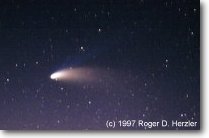|
Comets
The
@stro object for the week of 04/03/2000

image
(c) 1997 Roger D. Herzler
Comets. Comets
are large conglomerations of ice, dust and rock believed to be relics
left over from the formation of the solar system and are often compared
to "dirty snowballs". Comets are thought to reside in
the outer regions of the solar system known as the "Kuiper
Belt" and the "Oort
Cloud". Their distant orbit around the Sun is sometimes
perturbed by the gravity of passing stars or the large gas planets
and a comet can subsequently be thrown into our area of the solar
system where they are occasionally visible to the naked eye.
In the outer
regions of the solar system comets are dormant and appear much like
asteroids. When a
comet gets closer to the inner solar system it can come to life
and develop an active tail. This tail consists of gas, dust, ice
and rock which is sloughed off by the heat of the Sun pushed away
from the comet by the solar wind. An interesting note is that the
tail always points away from the Sun regardless of what direction
it is traveling in relation to the Sun.
Comet compositions
and descriptions can vary from comet to comet. Some of the chemicals
found in comets include methane, ethane, carbon monoxide, and they
are also sources of large amounts of water. Comets are thought to
have an average diameter of around 3 miles (5 kilometers), but some
comets exceed this amount, such as Hale-Bopp which was about 25
mi. (40 km) wide.
There are several
current theories that relate to comets. Those with large implications
to science include the theories that comets brought water to Earth's
surface and could have delivered chemicals essential to life on
Earth. Other theories even suggest that comets transport microscopic
bacterial life, although no direct evidence for this is currently
available.
It was believed
for eons that comets influenced human existence as harbingers of
doom or predictors of other major events yet to come. In present
times comets are not thought to directly affect life on Earth with
the possible exception of a cometary impact on Earth, or the observation
of various meteor showers left behind by comet tails. However, they
are followed intensely for many reasons including their close relationship
to the formation of the solar system.
Comets are one
of the few astronomical bodies that a person can name for themselves
- the discoverer of a new comet gets to name it, so comets are usually
named after the person that found them.
| Some
recent famous naked-eye comets include: |
| Comet Hale-Bopp
(discovered in 1995) |
| Comet Hyakutake
(discovered in 1996) |
| Comet Shoemaker-Levy
9 (discovered in 1993) |
| Comet West
(1975) |
| Comet Bennett
(discovered in 1969) |
| Comet Halley
(first named in 1682) |
more
information about comets...
more
information about comets from the U. of Michigan...
more
about the Kuiper Belt and Oort Cloud...
make
a "kitchen comet"...
more
on Comet Hale-Bopp...
|